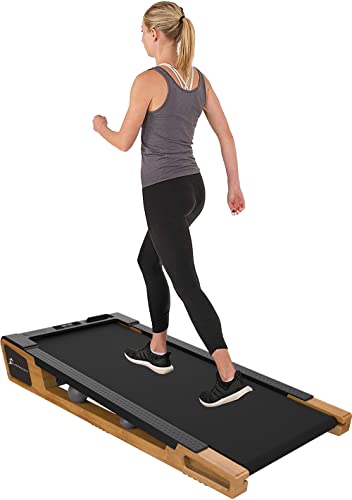The 10 Scariest Things About Walking Pad Non Electric
Exploring the Benefits of Walking Pads: The Non-Electric Choice
In the period of contemporary fitness services, where technology reigns supreme and sophistication is often related to electrical machines, a brand-new pattern is emerging in useful workout: the non-electric walking pad. These easy yet efficient tools are catching the interest of fitness lovers and casual walkers alike.
In this extensive guide, we will explore what walking pads are, their benefits, comparisons with standard treadmills, and offer responses to frequently asked concerns.
What is a Walking Pad?
A walking pad is a compact workout platform developed mainly for walking, jogging, or light running. Unlike traditional treadmills which rely on electrical power, non-electric walking pads operate on a manual system. Users move themselves forward by walking or running, harnessing their own body weight.
Secret Features of Non-Electric Walking Pads:
- Compact Design: Most walking pads are light-weight and foldable, making them easy to shop and transport.
- User Controlled: The speed and strength of the exercise depend on the user's own effort.
- No Plug Required: Perfect for energy-conscious individuals, these pads need no power consumption.
- Silent Operation: A quieter option to electric treadmills, making them appropriate for homes or shared spaces.
Advantages of Using Non-Electric Walking Pads
Using a non-electric walking pad provides a variety of benefits. Below are a few of the prominent benefits:
Benefit
Description
Affordable
Non-electric models are typically more economical than their electric equivalents, making them available to a more comprehensive audience.
Boosted Flexibility
Users can stroll or jog at their own rate, which is specifically advantageous for novices or those recovering from injuries.
Space-Saving Design
Due to their compact size, walking pads fit easily in smaller spaces, making them ideal for office or home use.
Low Maintenance
With no electrical components, these pads require very little maintenance and are less likely to break down.
Ecologically Friendly
No electricity indicates no environmental effect from energy usage, making them a terrific option for eco-conscious consumers.
Comparing Non-Electric Walking Pads to Traditional Treadmills
Function
Non-Electric Walking Pad
Conventional Treadmill
Power Source
Manual (user-powered)
Electric (plugged in)
Cost
Lower upfront expense
Greater initial financial investment
Size
Compact and portable
Larger, frequently fixed
Sound Level
Very peaceful
Can be loud, depending on motor and use
Personalization
Restricted user settings
Extensive settings (speed, incline, programs)
Physical Engagement
Greater intensity and effort required
Much easier to utilize but might encourage less engagement
How to Use a Non-Electric Walking Pad
Using a non-electric walking pad is uncomplicated. Here's an easy detailed guide:
- Set Up: Place the walking pad on a flat, steady surface area.
- Change the Pad: Ensure that it is at a comfortable position for use— most pads have adjustable angles to customize the walking experience.
- Warm-Up: Before using the pad, conduct a brief warm-up routine, which can consist of mild extending.
- Start Walking: Step onto the pad and start walking at a moderate rate. As your speed boosts, you will see the pad moving.
- Monitor Your Intensity: Pay attention to your heart rate and how you feel. Change Manual Treadmill For Under Desk according to your physical fitness level.
- Cool off: Gradually decrease your speed before stepping off the pad, followed by cooldown stretches.
Best Practices for Using Walking Pads
To maximize the benefits of non-electric walking pads, think about the following pointers:
- Incorporate Variety: Alternate between walking and jogging for a full-body workout.
- Engage Your Core: Maintain great posture by keeping your core engaged while using the pad.
- Hydration: Remember to hydrate before and after your workout.
- Consistency: Aim to utilize the walking pad regularly. Start with 15-20 minutes and gradually increase the duration.
Often Asked Questions
1. How effective are non-electric walking pads for weight loss?
Non-electric walking pads can be reliable for weight-loss when utilized consistently in conjunction with a healthy diet. Considering that they require more effort, they can enable higher calorie expenditure during exercises.
2. What is the weight capability of a lot of walking pads?
Many non-electric walking pads can support people approximately 250-300 pounds, depending on the model. Constantly examine the producer's specs for precise info.
3. Are there any recommended brands for walking pads?
Some popular brand names consist of InMovement, ProForm (manual designs), and ECHANFIT, each providing a series of functions customized to varied user choices.
4. Can non-electric walking pads be utilized outdoors?
These walking pads are generally designed for indoor usage. Utilizing them outdoors might expose them to weather conditions that might impact their sturdiness.
5. How do I store a walking pad?
Numerous non-electric walking pads are foldable. Just fold them up and store them in a closet, under a bed, or any practical space.
Non-electric walking pads offer a distinct and effective aerobic workout choice that stresses simplicity and availability. By allowing users to create their fitness routine without the restrictions of power cords and complex interfaces, these pads empower individuals across various fitness levels.
For anyone looking for a budget-friendly, space-saving, and efficient alternative to conventional exercise equipment, exploring the world of non-electric walking pads might be the perfect next action in their fitness journey. By choosing to purchase one of these flexible tools, individuals can promote much healthier habits while taking pleasure in the empowering experience of motion by themselves terms.
